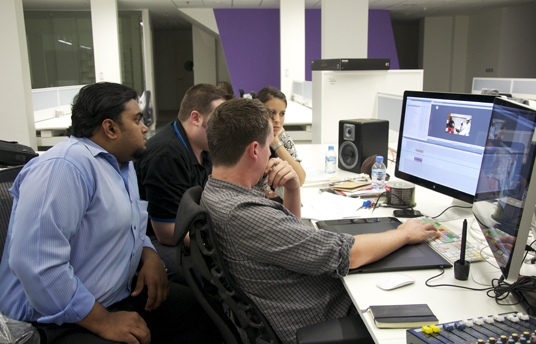DIY Documentary Part 4 - Post - production
Sep 07, 2011

Written by Jad Salfiti, Video Journalist, New Media
The final stage of filmmaking is called “post-production”. It is the stage where footage is logged, edited and the film takes shape.
Typically, the first part of this process involves “importing” the footage to editing software (such as Final Cut Pro or Avid). Once the footage is in the computer, the logging begins.
LOGGING RUSHES
Images from your production (“rushes”) need to be viewed, and organised, or “logged”. Logging the rushes means writing down notes from your footage. What happened? Where? When? What’s good? What’s bad? Logging done properly is a meticulous process that entails noting the most obvious detail (like a sarcastic laugh or a frustrated sigh) right down to every hesitation (a cough or a pause).
Yasir Khan tells us the importance of viewing the ‘world in shots’.
ياسر خان يحدثنا عن أهمية مشاهدة "العالم في مشاهد".
PAPER EDIT
Once rushes are logged and reviewed, many producers move onto a “paper edit” which is a process of laying out notes, logs, and rushes into a printed version of the film you wish to create. Some production teams, especially on shorter edits, will jump right into assembling video elements. But the longer the piece is, the more important it is to have a written guide. Nothing helps production more than organisation, and paper cuts help keep edits structured.
The log transcript is cut and paste into a paper edit, which is basically an assembly of all your strongest sound bites and images. The prime function of the paper edit is that it helps you manage all your ideas.
It is at this stage that the director/producer can sit with an editor and “assemble” the documentary. This collaboration is built on the director/producer articulating their vision to the editor.
Editors splice all of the usable footage together into a coherent storyline according to the script. Background music can be added to create dramatic or comical effects. Graphics and special effects teams add computer-generated images and backgrounds to enhance the footage.
STRING-OUT
The next version of your film is called a “string-out”. In the string-out phase, don’t worry about anything but the overall elements of your film, which should be starting to take shape. In your string-out, try to find your beginning, your middle, and your end.
ASSEMBLY EDIT
The next stage is the assembly edit, which is based on your paper edit. It is your first attempt at a structure and shows you the bigger picture. This evolves into a rough cut, which will be an early, crude version of your final documentary.
This is tweaked into a “fine cut” and then the “locked picture”.
The “locked picture” is your final film, with no further changes to be made.
Yasir Khan tells us what a documentary is.
ياسر خان يعرفنا بمعنى الفيلم الوثائقي
With the final film, we are brought to the end of the production process and our last blog on the documentary production process. We’ve attempted to demystify the nuts and bolts of documentary filmmaking but as the participants in our Documentary Workshop discovered – no better learning experience can be accomplished than you doing it yourself.
Sources:
http://newdocediting.com/client-resources/stages-of-post-production/
http://www.bbctraining.com/onlineCourse.asp?tID=2145&cat=0